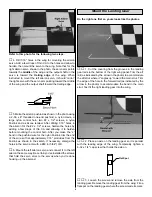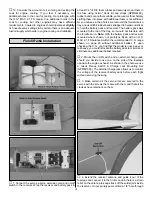
Make all engine adjustments from behind the rotating propeller.
The engine gets hot! Do not touch it during or right after
operation. Make sure fuel lines are in good condition so fuel
will not leak onto a hot engine, causing a fire.
To stop a glow engine, cut off the fuel supply by closing off
the fuel line or following the engine manufacturer's
recommendations. Do not use hands, fingers or any other
body part to try to stop the engine. To stop a gasoline
powered engine, an on/off switch should be connected to
the engine coil. Do not throw anything into the propeller of a
running engine.
Read and abide by the following Academy of Model
Aeronautics Official Safety Code:
1.
I will not fly my model aircraft in sanctioned events, air
shows, or model flying demonstrations until it has been
proven to be airworthy by having been previously
successfully flight tested.
2.
I will not fly my model aircraft higher than approximately
400 feet within 3 miles of an airport without notifying the
airport operator. I will give right of way to and avoid flying in
the proximity of full scale aircraft. Where necessary an
observer shall be used to supervise flying to avoid having
models fly in the proximity of full scale aircraft.
3.
Where established, I will abide by the safety rules for the
flying site I use and I will not willfully and deliberately fly my
models in a careless, reckless and/or dangerous manner.
7.
I will not fly my model unless it is identified with my
name and address or AMA number, on or in the model.
9.
I will not operate models with pyrotechnics (any device
that explodes, burns, or propels a projectile of any kind).
1.
I will have completed a successful radio equipment
ground check before the first flight of a new or repaired model.
2.
I will not fly my model aircraft in the presence of
spectators until I become a qualified flier, unless assisted by
an experienced helper.
3.
I will perform my initial turn after takeoff away from the
pit or spectator areas and I will not thereafter fly over pit or
spectator areas, unless beyond my control.
4.
I will operate my model using only radio control
frequencies currently allowed by the Federal
Communications Commission...
Since the Great Planes Ryan STA qualifies as a “giant
scale” model and is therefore eligible to fly in IMAA
events, we've printed excerpts from the IMAA Safety
Code which follows.
For the purpose of the following IMAA Safety Code, the term
Giant Scale shall refer to radio controlled model aircraft,
either scale or non-scale, which have a wingspan of 80
inches or more for monoplanes and 60 inches or more for
multi-winged model aircraft and have a ramp weight (fueled
and ready to fly) of 55 lbs. or less.
1.1 Adherence to Code: This safety code is to be
strictly followed.
1.2 The most current AMA Safety Code in effect is to be
observed. However, the competition sections of the code
may be disregarded.
3.4 Flight Testing: All Giant Scale R/C aircraft are to have
been flight tested and flight trimmed with a minimum of six
flights before the model is allowed to fly at an IMAA
Sanctioned event.
3.5 Proof of Flight: The completing and signing of the
Declaration section of the Safety Inspection form by the pilot
(or owner) shall document as fact that each aircraft has
been successfully flight-tested and proven airworthy prior to
an IMAA event.
5.1 All magneto spark ignition engines must have a coil
grounding switch on the aircraft to stop the engine. This will
also prevent accidental starting of the engine. This switch shall
be readily available to both pilot and helper. This switch is to
be operated manually and without the use of the radio system.
Section 5.0: Emergency Engine
Shut Off (“Kill Switch”)
Section 3.0: Safety Check
Section 1.0: Safety Standard
Definition
IMAA SAFETY CODE (Excerpt)
Radio Control
General
AMA SAFETY CODE (Excerpt)
22







































